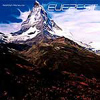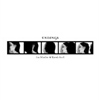Polyvinyl Just like their previous album, Face.(a,this year's release from Collections of Colonies of Bees manages tosqueak in very quietly just underneath the radar, without a lot of hypeor fanfare, to surprisingly become one of my top albums of the year.The formula holds close to the last album: taking an instrumental rock"band" setup and mutating it through inhuman editing. It's a setupwhich has gained popularity in the last couple years with groups likeRadian, Nudge, Trapist, and Supersilent, but Collections of Colonies ofBees have become masters at the art. Pele have decided to call itquits, however, the Collections lineup is now almost identical to Pele,with Jon Mueller and Chris Rosenau bringing other Pele alumni Jon Minoron board this time along with Jim Schoenecker. (Perhaps they weregetting tired of being in TOO many bands—see above review!) Bright andspringy guitar melodies live harmoniously with manipulated twitters,beats and whirrs, while miscellaneous unidentifiable objects providerhythm colorization in spots. Fans of both the upbeat Pele andMuller/Rosenau's improvisational experimental outings find a mediumhere, as the line is delicately walked between pop melodies and nerdyimprovisation. Some songs, (nine out of ten are named "fun") are mostdecidedly organically driven, while some are clearly more electronic.The story of the recordings is that the band took a number of differentapproaches to each composition, and the Japanese version of Customer,on Some of Us, uses the more electronic versions of the more organicsongs here and more organic versions of the more electronic songscontained here. If that's not confusing enough, a vinyl edition of therecord contains only the "electronic" songs from both. While a disclike this might be good for an afternoon read at home, I highlyrecommend playing at loud volumes to fully enjoy some of the fantasticlow frequency bass sounds and alien ticks which dance around the ears.Like a fantastic sushi dinner, at the end I'm eager for more, andunfortunately that means getting a hold of Customer's Japanese counterpart.
Just like their previous album, Face.(a,this year's release from Collections of Colonies of Bees manages tosqueak in very quietly just underneath the radar, without a lot of hypeor fanfare, to surprisingly become one of my top albums of the year.The formula holds close to the last album: taking an instrumental rock"band" setup and mutating it through inhuman editing. It's a setupwhich has gained popularity in the last couple years with groups likeRadian, Nudge, Trapist, and Supersilent, but Collections of Colonies ofBees have become masters at the art. Pele have decided to call itquits, however, the Collections lineup is now almost identical to Pele,with Jon Mueller and Chris Rosenau bringing other Pele alumni Jon Minoron board this time along with Jim Schoenecker. (Perhaps they weregetting tired of being in TOO many bands—see above review!) Bright andspringy guitar melodies live harmoniously with manipulated twitters,beats and whirrs, while miscellaneous unidentifiable objects providerhythm colorization in spots. Fans of both the upbeat Pele andMuller/Rosenau's improvisational experimental outings find a mediumhere, as the line is delicately walked between pop melodies and nerdyimprovisation. Some songs, (nine out of ten are named "fun") are mostdecidedly organically driven, while some are clearly more electronic.The story of the recordings is that the band took a number of differentapproaches to each composition, and the Japanese version of Customer,on Some of Us, uses the more electronic versions of the more organicsongs here and more organic versions of the more electronic songscontained here. If that's not confusing enough, a vinyl edition of therecord contains only the "electronic" songs from both. While a disclike this might be good for an afternoon read at home, I highlyrecommend playing at loud volumes to fully enjoy some of the fantasticlow frequency bass sounds and alien ticks which dance around the ears.Like a fantastic sushi dinner, at the end I'm eager for more, andunfortunately that means getting a hold of Customer's Japanese counterpart.
samples:



 Story goes that a friend or fan passed ex-Can vocalist Damo Suzuki aCul de Sac record on the lucky hunch that he'd find a kindred spirit inthe Boston hard psych outfit's instrumental, eastern-leaning, andpercussion-heavy sound. Suzuki was apparently so impressed that heproposed a massive series of all-improvised live dates with the band,spanning two years and several continents, and beginning without thehelp of a single rehearsal. Abhayamudra'stwo discs collect the best moments from over 40 shows, and despite therecent flood of classic Can reissues/remasters, it's hard not to beimpressed by the fruits of this complimentary union. Cul de Sac'stalents for improvisation have been well established by a string ofambitious, often conceptual full-length releases, but their ability toaccommodate Suzuki's iconoclastic style of nonsense trance rambling iscontinually surprising and entirely capable of spanning Abhayamudra's2+ hours without a drift into the pained repetition common amongkraut-imitators. What the band lacks of Can's funk (nearly all of it)they make up for in an intensely layered and propulsive performance,due in large part to Glenn Jones' guitar, bridging delicate raga motifsand wall-of-feedback charges with the control of and responsivetechnique of a virtuoso. Jon Proudman's drumming steers from Can'sexultant rhythms toward darker, flooding beats that fill every gap, andevery percussion junkie's expectation, without ever sounding like toomuch. Suzuki's vocal, no doubt in response to the decreased buoyancy ofthe music and the stresses of constant improv, takes a moreaccompanying approach here than ever with Can, becoming a steady streamof multi-syllabic, often predictably deconstructed language. A fewsections find the vocalist reaching for more guttural sounds andengaging the extremes of his unique instrument, but Suzuki'sperformance, at least here on disc, leaves me wanting more variation.The band is able to cover the slack with dips into its elegantdrone-based recent work and the burstings of a rougher-hewn, crassersound than I ever thought they were capable. Suzuki's improvisedinclusion, it seems, has succeeded in breaking down a bit of Cul deSac's studied underpinnings, but at the cost of some of the singer'sexpressiveness, though I would argue that Suzuki's talent suffersmainly as a result of his self-imposed doctrine of improvisation. Whileno doubt conceived in an improvised setting, Suzuki's most impressivework with his former band feels too often linked to the dramatic andconstructed song elements that are necessarily absent here. Thesecriticisms are of course relative, and fans of either party will surelyfind more than a few sections within these discs to embraceunreservedly. Most impressive, though, will be the amount ofunrehearsed magic that these short hours represent, a significantachievement regardless of past prejudice. A studio session might evenhave produced too conflicted or divisive a meeting of suchauthoritative forces.
Story goes that a friend or fan passed ex-Can vocalist Damo Suzuki aCul de Sac record on the lucky hunch that he'd find a kindred spirit inthe Boston hard psych outfit's instrumental, eastern-leaning, andpercussion-heavy sound. Suzuki was apparently so impressed that heproposed a massive series of all-improvised live dates with the band,spanning two years and several continents, and beginning without thehelp of a single rehearsal. Abhayamudra'stwo discs collect the best moments from over 40 shows, and despite therecent flood of classic Can reissues/remasters, it's hard not to beimpressed by the fruits of this complimentary union. Cul de Sac'stalents for improvisation have been well established by a string ofambitious, often conceptual full-length releases, but their ability toaccommodate Suzuki's iconoclastic style of nonsense trance rambling iscontinually surprising and entirely capable of spanning Abhayamudra's2+ hours without a drift into the pained repetition common amongkraut-imitators. What the band lacks of Can's funk (nearly all of it)they make up for in an intensely layered and propulsive performance,due in large part to Glenn Jones' guitar, bridging delicate raga motifsand wall-of-feedback charges with the control of and responsivetechnique of a virtuoso. Jon Proudman's drumming steers from Can'sexultant rhythms toward darker, flooding beats that fill every gap, andevery percussion junkie's expectation, without ever sounding like toomuch. Suzuki's vocal, no doubt in response to the decreased buoyancy ofthe music and the stresses of constant improv, takes a moreaccompanying approach here than ever with Can, becoming a steady streamof multi-syllabic, often predictably deconstructed language. A fewsections find the vocalist reaching for more guttural sounds andengaging the extremes of his unique instrument, but Suzuki'sperformance, at least here on disc, leaves me wanting more variation.The band is able to cover the slack with dips into its elegantdrone-based recent work and the burstings of a rougher-hewn, crassersound than I ever thought they were capable. Suzuki's improvisedinclusion, it seems, has succeeded in breaking down a bit of Cul deSac's studied underpinnings, but at the cost of some of the singer'sexpressiveness, though I would argue that Suzuki's talent suffersmainly as a result of his self-imposed doctrine of improvisation. Whileno doubt conceived in an improvised setting, Suzuki's most impressivework with his former band feels too often linked to the dramatic andconstructed song elements that are necessarily absent here. Thesecriticisms are of course relative, and fans of either party will surelyfind more than a few sections within these discs to embraceunreservedly. Most impressive, though, will be the amount ofunrehearsed magic that these short hours represent, a significantachievement regardless of past prejudice. A studio session might evenhave produced too conflicted or divisive a meeting of suchauthoritative forces. Having one or two good songs sandwiched between pointless exercises inmelodic looping is quite frustrating. Even worse is when a minute totwo minutes of a song are utterly captivating while the rest of itsimply seems like an effort to move up a very steep hill. Locatedsomewhere in the middle of this messy album is a vacuum of badproduction that consumes all of the stumbling rhythms and accentuatesthe rather flat and circular melodies. I'm never quite sure which I'msupposed to be listening to more and a complete lack of dynamics in thesong-writing only makes the banality of Heimlich Maneuverall the more blinding. For example, near the end of the album"Faulhorn" begins to resonate above and beyond the routine that hasbeen the entirety of the album; but as the song progresses, it becomesobvious that what I'm dealing with is actually a sonic cock-tease. As abass line and regiment of percussive sounds march into the piece,everything begins to blend together into a murky soup. Repeat andrecycle and a large portion of the album is enumerated and elucidatedas much as is possible within the realms of boredom. "Ro3" and "Dex"both flaunt a predisposition towards excellence and, to some extent,"Dex" actually succeeds. Maybe the track's short running time has alittle bit to do with its success or maybe it's because Everest don'tbother with adding layers of unnecessary instrumentation andornamentation. Everest work best on a simple and direct basis: anyexuberance or decoration kills the mood they can develop with solittle. "Falke," when it begins, rolls like a gorgeous thunder andcontinues to do so without being stuffed full of spiffy effects orabrupt changes in thematic direction. Even if the band could escapetheir inability to keep everything within a creatively controllablespace, they'd have to deal with the monotonous tone of the album as awhole. Many of their warm and welcoming synth tones feel rehashed bythe time "Channel Sky" cuts out. There's something lovable about thisrecord, but it's ultimately just another example of how to loop beatsand melodies ad nauseam. To be fair, there are a few tracks thatcould've made up the contents of a beautiful little EP, but within theconfines of the rest of the album they suffer considerably.
Having one or two good songs sandwiched between pointless exercises inmelodic looping is quite frustrating. Even worse is when a minute totwo minutes of a song are utterly captivating while the rest of itsimply seems like an effort to move up a very steep hill. Locatedsomewhere in the middle of this messy album is a vacuum of badproduction that consumes all of the stumbling rhythms and accentuatesthe rather flat and circular melodies. I'm never quite sure which I'msupposed to be listening to more and a complete lack of dynamics in thesong-writing only makes the banality of Heimlich Maneuverall the more blinding. For example, near the end of the album"Faulhorn" begins to resonate above and beyond the routine that hasbeen the entirety of the album; but as the song progresses, it becomesobvious that what I'm dealing with is actually a sonic cock-tease. As abass line and regiment of percussive sounds march into the piece,everything begins to blend together into a murky soup. Repeat andrecycle and a large portion of the album is enumerated and elucidatedas much as is possible within the realms of boredom. "Ro3" and "Dex"both flaunt a predisposition towards excellence and, to some extent,"Dex" actually succeeds. Maybe the track's short running time has alittle bit to do with its success or maybe it's because Everest don'tbother with adding layers of unnecessary instrumentation andornamentation. Everest work best on a simple and direct basis: anyexuberance or decoration kills the mood they can develop with solittle. "Falke," when it begins, rolls like a gorgeous thunder andcontinues to do so without being stuffed full of spiffy effects orabrupt changes in thematic direction. Even if the band could escapetheir inability to keep everything within a creatively controllablespace, they'd have to deal with the monotonous tone of the album as awhole. Many of their warm and welcoming synth tones feel rehashed bythe time "Channel Sky" cuts out. There's something lovable about thisrecord, but it's ultimately just another example of how to loop beatsand melodies ad nauseam. To be fair, there are a few tracks thatcould've made up the contents of a beautiful little EP, but within theconfines of the rest of the album they suffer considerably. While the days of guitar maximalism are long in Cranes' past, Particles & Waves showcases a band who is doing a very good job when they attempt to recapture the stunningly haunting sound that drew so many fans a decade ago. On songs like "K56," and "Here Comes the Snow," Alison Shaw's piercingly high pitched voice is fragile and lonely, almost naked against the patient and pretty melodies. However, there are certain points where I simply cannot connect with the music.
While the days of guitar maximalism are long in Cranes' past, Particles & Waves showcases a band who is doing a very good job when they attempt to recapture the stunningly haunting sound that drew so many fans a decade ago. On songs like "K56," and "Here Comes the Snow," Alison Shaw's piercingly high pitched voice is fragile and lonely, almost naked against the patient and pretty melodies. However, there are certain points where I simply cannot connect with the music. Continuing the label's tradition of beautifully packaged, limited edition releases, Endingsis the second text + music project from Crouton founder Jon Mueller. Anestablished and diverse drummer, playing with indie instrumentalistsPele, Collections of Colonies of Bees, and a myriad of improvensembles, Mueller's written works offer unique glimpses into thestrange reality of a clearly eccentric artist whose role is nevermerely complimentary. Endings combines eleven very shortstories (in a boxed, spineless book) with a 30-min. CD-R of readingmusic, and several black-and-white illustrations by Kaveh Soofi, theBay Area graphic artist who designed the cover for Pele's last album.Mueller's stories are by far the most exciting piece of the puzzle. Theauthor uses the concept of "endings" to create postcard lengthvignettes launching the reader into a darkly absurd and chaotic worldwhere narrative seems to strive immediately toward a propheticconclusion. The extreme shortness of the texts provides that nocharacter or scenario is developed outside of a series of scrupulous,often ridiculous details serving only the anticipation of some unifyingfinale. Mueller always delivers the goods, in the sense that he hurlseach clipped plotline into an unmistakable, impassable "end;" howeverhis endings are never the epiphanies his stories require. Instead theyoffer only the further mystification of an already lost cast ofcharacters, managing to transform a clever variety of hum-drum pursuitsand circumstances into windows to another hellish dimension. A man,inexplicably followed while on the way to the grocery store, eventuallyconfronts his enraged pursuer, severs his own finger, and proceeds toreverse the chase, threatening the other man with the bloody appendage.Another character puts on a play for his dinner guests starring apicture of his dead son, whom he directs: "Sing, boy! Sing!" A businessexecutive returns from an emergency call to find his interruptedinterviewee sipping from the potential employer's coffee cup, his eyesrising in blank defiance. Most impressive is Mueller's ability tostreamline each story with a detail-driven first-person narrative thatassumes normalcy and connectedness, only to completely break down bythe end. More than simple plot twists, the author's endings might becalled 'anti-epiphanies' in the way they are positioned, through astriking economy of language, to effectively dismantle the story'sprior logic. Mueller's musical accompaniment is unlike anything I'veheard from him yet and clearly serves the box's theme. A fadedsymphonic loop plays over and over to simulate a continuous,regenerating "ending," essentially a false ending that, in its 19-sec.length, reminds me of the obscured, darkened tones of a Badalamentiscore played out like one of William Basinski's Disintegration Loops,only without disintegrating. The atmosphere is soothing for a smallsecond, but ultimately turns to a sinister, anxious tension, both aptand almost nauseating when coupled with Mueller's words. Soofi'sillustrations are less fitting, but interesting nonetheless. From thelook of it they are digital images arranged comic-strip-style butwithout any explicit narrative. The images are almost all stylized,grey toned portraits, progressively clouded, shadowed, fragmented,cropped, and later barraged by clusters of nail-covered blocks. I cansee comparisons to Francis Bacon's portraiture, with the sectionedmurkiness and sketchy inaccuracies reminding me of animations by SouthAfrican artist William Kentridge, though Soofi's work has an unsettlinggeometric base that feels very unique. Endings is well worth itto anyone keen on interesting packaging and multimedia formats; I amstill involved in picking apart and connecting the contents of thisbeautiful release, no end in sight.
Continuing the label's tradition of beautifully packaged, limited edition releases, Endingsis the second text + music project from Crouton founder Jon Mueller. Anestablished and diverse drummer, playing with indie instrumentalistsPele, Collections of Colonies of Bees, and a myriad of improvensembles, Mueller's written works offer unique glimpses into thestrange reality of a clearly eccentric artist whose role is nevermerely complimentary. Endings combines eleven very shortstories (in a boxed, spineless book) with a 30-min. CD-R of readingmusic, and several black-and-white illustrations by Kaveh Soofi, theBay Area graphic artist who designed the cover for Pele's last album.Mueller's stories are by far the most exciting piece of the puzzle. Theauthor uses the concept of "endings" to create postcard lengthvignettes launching the reader into a darkly absurd and chaotic worldwhere narrative seems to strive immediately toward a propheticconclusion. The extreme shortness of the texts provides that nocharacter or scenario is developed outside of a series of scrupulous,often ridiculous details serving only the anticipation of some unifyingfinale. Mueller always delivers the goods, in the sense that he hurlseach clipped plotline into an unmistakable, impassable "end;" howeverhis endings are never the epiphanies his stories require. Instead theyoffer only the further mystification of an already lost cast ofcharacters, managing to transform a clever variety of hum-drum pursuitsand circumstances into windows to another hellish dimension. A man,inexplicably followed while on the way to the grocery store, eventuallyconfronts his enraged pursuer, severs his own finger, and proceeds toreverse the chase, threatening the other man with the bloody appendage.Another character puts on a play for his dinner guests starring apicture of his dead son, whom he directs: "Sing, boy! Sing!" A businessexecutive returns from an emergency call to find his interruptedinterviewee sipping from the potential employer's coffee cup, his eyesrising in blank defiance. Most impressive is Mueller's ability tostreamline each story with a detail-driven first-person narrative thatassumes normalcy and connectedness, only to completely break down bythe end. More than simple plot twists, the author's endings might becalled 'anti-epiphanies' in the way they are positioned, through astriking economy of language, to effectively dismantle the story'sprior logic. Mueller's musical accompaniment is unlike anything I'veheard from him yet and clearly serves the box's theme. A fadedsymphonic loop plays over and over to simulate a continuous,regenerating "ending," essentially a false ending that, in its 19-sec.length, reminds me of the obscured, darkened tones of a Badalamentiscore played out like one of William Basinski's Disintegration Loops,only without disintegrating. The atmosphere is soothing for a smallsecond, but ultimately turns to a sinister, anxious tension, both aptand almost nauseating when coupled with Mueller's words. Soofi'sillustrations are less fitting, but interesting nonetheless. From thelook of it they are digital images arranged comic-strip-style butwithout any explicit narrative. The images are almost all stylized,grey toned portraits, progressively clouded, shadowed, fragmented,cropped, and later barraged by clusters of nail-covered blocks. I cansee comparisons to Francis Bacon's portraiture, with the sectionedmurkiness and sketchy inaccuracies reminding me of animations by SouthAfrican artist William Kentridge, though Soofi's work has an unsettlinggeometric base that feels very unique. Endings is well worth itto anyone keen on interesting packaging and multimedia formats; I amstill involved in picking apart and connecting the contents of thisbeautiful release, no end in sight. These four musicians completely overcome the wedge so often forced between musical excellence and immediate accessibility. Too many buckets of wank and showmanship have been filled in the pursuit of making a technically demanding record that simultaneously sounds and feels exciting. "SZ2" laughs in the face of that problem with bravado.
These four musicians completely overcome the wedge so often forced between musical excellence and immediate accessibility. Too many buckets of wank and showmanship have been filled in the pursuit of making a technically demanding record that simultaneously sounds and feels exciting. "SZ2" laughs in the face of that problem with bravado. Off/On is a small but important step forward for Forma. Compared to the eponymous release from last year, it is similar in its sonic trappings, but for a group whose whole identity is fixed around nostalgia for kosmische synth loops and drum machine motorik beats, this record demonstrates how they can grow beyond their influences. The signature sound of the group is fleshed out in greater layers, with better production, and teems with hopeful optimism on its standout songs, hinting at an ambitious streak about to surface.
Off/On is a small but important step forward for Forma. Compared to the eponymous release from last year, it is similar in its sonic trappings, but for a group whose whole identity is fixed around nostalgia for kosmische synth loops and drum machine motorik beats, this record demonstrates how they can grow beyond their influences. The signature sound of the group is fleshed out in greater layers, with better production, and teems with hopeful optimism on its standout songs, hinting at an ambitious streak about to surface. Despite his seeming obsession with angels (just look at the list of titles of Earth’s albums and songs), Dylan Carlson’s current obsession with fairies and the occult history of England came as a bit of a surprise. Images of him playing fey faux folk music in tights came to mind but I decided to give him the benefit of the doubt. I am glad I did as his drcarlsonalbion project is turning out to be just as intriguing as his work with Earth.
Despite his seeming obsession with angels (just look at the list of titles of Earth’s albums and songs), Dylan Carlson’s current obsession with fairies and the occult history of England came as a bit of a surprise. Images of him playing fey faux folk music in tights came to mind but I decided to give him the benefit of the doubt. I am glad I did as his drcarlsonalbion project is turning out to be just as intriguing as his work with Earth. A combination of esoteric neofolk and electronic experimentation, Circulation of Light (Nathaniel Ritter of Kinit Her and Burial Hex, among others) sits nicely between those two genres. While I tend to find artists who overly favor one end of those two poles monotonous over time, Acheiropoeita does not have that problem in the slightest.
A combination of esoteric neofolk and electronic experimentation, Circulation of Light (Nathaniel Ritter of Kinit Her and Burial Hex, among others) sits nicely between those two genres. While I tend to find artists who overly favor one end of those two poles monotonous over time, Acheiropoeita does not have that problem in the slightest. This is the eponymous debut album from Andrea Belfi (percussion), BJ Nilsen (electronics), and Simon James Phillips (piano). Recorded live in a Berlin church. the album comes across as an isolating, but effective combination of these three different artists, coming together to produce something that sounds like none of them in particular, but a whole that has its own singular sound.
This is the eponymous debut album from Andrea Belfi (percussion), BJ Nilsen (electronics), and Simon James Phillips (piano). Recorded live in a Berlin church. the album comes across as an isolating, but effective combination of these three different artists, coming together to produce something that sounds like none of them in particular, but a whole that has its own singular sound.
